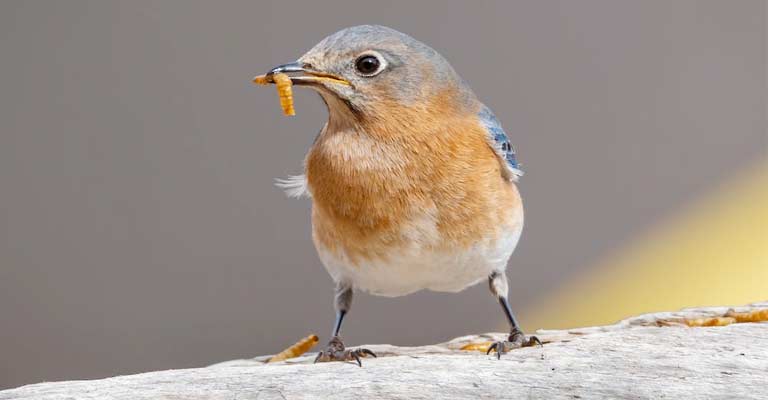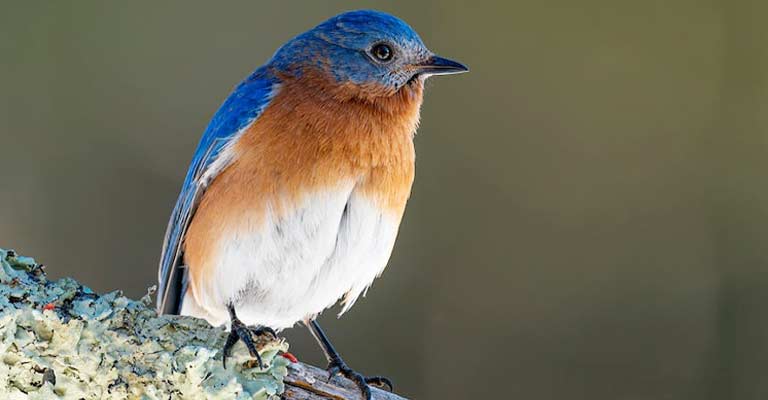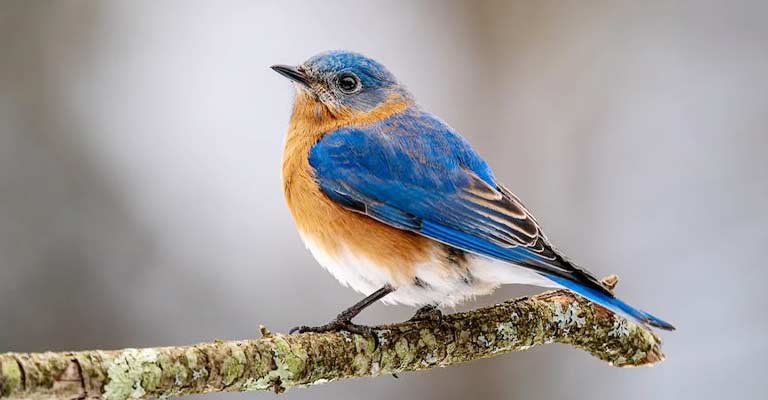Bluebirds, with their dazzling plumage and melodious songs, have captivated human imagination across cultures, embodying a tapestry of meanings and symbolism.
As we explore the world of bluebirds, it becomes evident that these enchanting creatures transcend mere avian presence, becoming vessels of profound significance.
From cultural symbolism to myths, each aspect of the bluebird unveils layers of interpretation that resonate with universal themes of hope, joy, and spiritual connection.
This exploration delves into bluebird meanings and symbolism, unraveling the stories and cultural narratives that have woven these birds into the fabric of human consciousness.

Bluebird Meanings And Symbolism
Bluebirds are charming and colorful birds that captivate people with their striking appearance and melodious songs. Here are some physical features of bluebirds, unraveling the meanings embedded in each trait:
Vibrant Blue Plumage
Bluebirds are renowned for their stunning blue plumage, symbolizing tranquility and happiness. The vibrant shade of blue reflects the sky, evoking a sense of freedom and open possibilities.
This striking coloration is a visual representation of the bird’s joyous spirit and resonates with observers as a symbol of optimism.
Distinctive Reddish-Brown Breast
The reddish-brown breast of the bluebird serves as a focal point against its blue feathers. This feature is associated with warmth, love, and nurturing.
In many cultures, the color red is linked to strong emotions and passion, suggesting that bluebirds carry not only a sense of joy but also deep emotional connections.
Slender and Curved Beak
The slender and curved beak of the bluebird is a tool for precision and adaptability. This physical feature enables the bird to extract insects and berries efficiently, symbolizing resourcefulness and adaptability in navigating life’s challenges.
The beak embodies the idea of seizing opportunities with grace and accuracy.
Sharp, Observant Eyes

Bluebirds possess sharp and observant eyes, emphasizing their keen awareness of their surroundings. This trait symbolizes vigilance, insight, and the ability to see beyond surface appearances.
The bird’s watchful gaze is a reminder to stay attentive and perceptive in our own lives.
Delicate Wings and Agile Flight
The delicate wings of bluebirds contribute to their agile and graceful flight. This feature embodies freedom and the ability to navigate through life’s journey with elegance.
Bluebirds teach us the importance of embracing our freedom while maintaining a sense of grace and lightness.
Compact Body Structure
Bluebirds have a compact and streamlined body structure, highlighting efficiency and simplicity. This physical attribute represents the beauty of simplicity and the idea that sometimes, less is more.
The bird’s compact form encourages us to focus on essentials and find beauty in simplicity.
Distinctive Song
The melodious and distinctive song of the bluebird is a source of inspiration and joy. It signifies communication, self-expression, and the power of a positive voice.
The bluebird’s song encourages us to express ourselves authentically and embrace the potential for harmony in our lives.
Here are some cultural symbols associated with the bluebird, shedding light on the diverse meanings ascribed to this cherished avian creature.
Happiness and Joy in Western Cultures
In Western cultures, the bluebird is an emblem of happiness and joy. Folklore often depicts these birds as bearers of good fortune, and their presence is thought to bring positive vibes and a sense of optimism.
The vivid blue plumage of the bluebird is symbolic of clear skies and brighter days, aligning the bird with themes of hope and happiness.
Love and Fidelity in Native American Traditions
Native American cultures often associate bluebirds with love and fidelity. The gentle and nurturing nature of these birds is seen as a reflection of strong familial bonds.
Bluebirds are revered as symbols of enduring love and commitment, with their appearance in folklore often tied to romantic tales and the importance of loyalty within relationships.
Transformation and Renewal in Chinese Symbolism
Chinese symbolism attributes themes of transformation and renewal to the bluebird. The bird’s vibrant blue plumage is seen as a representation of the sky, symbolizing infinite possibilities and a connection to the divine.
In Chinese culture, bluebirds are often linked to the idea of positive change and the renewal of life.
Spiritual Messengers in Native American and Celtic Traditions
Both Native American and Celtic traditions regard bluebirds as spiritual messengers. These birds are believed to bridge the earthly realm and the spirit world, delivering messages from ancestors or divine forces.
Their presence is considered auspicious, signifying guidance and protection from the spiritual realm.
Harmony and Prosperity in Japanese Culture
In Japanese folklore, the bluebird is a symbol of harmony and prosperity. The bird’s gentle and harmonious song is associated with peace and balance.
Bluebirds are often depicted in art and literature as heralds of good fortune, representing a harmonious coexistence with nature and the potential for prosperity.
Mental and Emotional Well-being in Native American Beliefs
Some Native American tribes view bluebirds as symbols of mental and emotional well-being. The calming effect of their soothing melodies is thought to bring peace of mind and emotional healing.
Bluebirds, in this context, are seen as allies in promoting mental health and overall wellness.
Good Luck and Protection in Russian Folklore
Russian folklore attributes a sense of good luck and protection to the bluebird. It is believed that encountering a bluebird brings positive energy and guards against misfortune.
The bird’s presence is associated with blessings and a shield against negative forces, making it a cherished symbol in Russian cultural beliefs.
What Are Some Common Myths Of The Bluebird?

Bluebirds, with their radiant plumage and sweet melodies, have woven themselves into the tapestry of myths across various cultures.
These myths often portray bluebirds as symbols of hope, joy, and mystical significance. Here are some common myths associated with the bluebird, delving into the cultural narratives that have shaped the perception of these enchanting birds.
Bringer of Spring in European Folklore
One prevalent myth in European folklore depicts the bluebird as the harbinger of spring. Legend has it that these birds bring warmth and renewal as they return after winter, signaling the arrival of the season of growth and blossoming. The vibrant blue plumage is seen as a celebration of life’s resurgence.
Messenger of Happiness in Native American Traditions
Native American myths often portray the bluebird as a messenger of happiness. Believed to carry positive energy, the bluebird is seen as a symbol of joy and good fortune.
Encounters with these birds are thought to bring blessings and a reminder of the importance of embracing happiness in one’s life.
Symbol of Transformation in Chinese Mythology
Chinese mythology associates the bluebird with transformation and metamorphosis. Legends tell of bluebirds guiding individuals through life changes and spiritual growth.
The bird’s vivid blue feathers are seen as a representation of the ever-changing sky, symbolizing the transformative journey of life.
Divine Connection in Native American Lore
Some Native American tribes consider the bluebird as a symbol of a divine connection. According to certain myths, bluebirds are spiritual messengers, delivering guidance and wisdom from the spirit world.
Their appearance is often interpreted as a sign of divine intervention or protection.
Love and Fidelity in Greek Mythology
In Greek mythology, the bluebird is associated with love and fidelity. It is often linked to the stories of gods and goddesses who transformed into birds to express their devotion. The bluebird’s presence in these tales symbolizes enduring love and unwavering loyalty.
Soul Guide in Slavic Folklore
Slavic folklore suggests that the bluebird serves as a guide for the soul. The bird is believed to accompany departed souls on their journey to the afterlife, providing comfort and guidance.
Bluebirds are thus regarded as spiritual companions, easing the transition between life and death.
Symbol of Good Fortune in Japanese Beliefs
Japanese folklore views the bluebird as a symbol of good fortune. It is thought that encountering a bluebird brings luck and positive outcomes. The bird’s harmonious presence is seen as a manifestation of good things to come, making it a cherished symbol in Japanese cultural beliefs.
FAQs
Is there a spiritual significance associated with bluebirds?
Yes, bluebirds are often considered spiritual messengers in Native American and Celtic traditions. Their presence is believed to bridge the gap between the earthly and spiritual realms, offering guidance and protection.
Why are bluebirds associated with love and fidelity?
Bluebirds, with their nurturing nature, are symbols of enduring love and fidelity in Native American and Greek mythology. Their portrayal in romantic tales emphasizes loyalty and strong emotional bonds.
Do bluebirds signify transformation?
Yes, bluebirds are associated with transformation and renewal in Chinese mythology. Their vivid blue plumage represents the ever-changing sky, symbolizing positive life transformations and spiritual growth.
What does the bluebird’s song represent in symbolism?
The melodious song of the bluebird represents communication, self-expression, and the power of a positive voice. It symbolizes harmony, encouraging authentic self-expression and embracing positive communication.
Are bluebirds considered symbols of good luck?
Yes, in various cultures, encountering a bluebird is believed to bring good luck and positive outcomes. Their presence is often associated with blessings and protection against misfortune.
Conclusion
In the delicate flutter of their wings and the vibrant hues of their plumage, bluebirds emerge as timeless symbols of inspiration and meaning. The exploration of bluebird meanings and symbolism unveils a universal language that transcends borders and cultures.
Whether representing hope in the changing seasons, serving as messengers of joy, or embodying the simplicity of life’s beauty, bluebirds stand as poignant reminders of the interconnectedness between nature and human experience.
As we reflect on the rich tapestry of interpretations surrounding these beloved birds, we find that the bluebird, with its myriad meanings, continues to soar through the collective consciousness, inviting us to embrace the profound messages it carries.